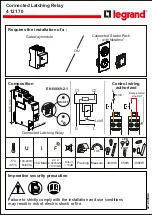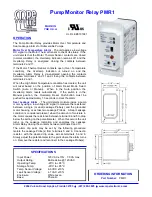
2
350 FEEDER PROTECTION SYSTEM – QUICKSTART GUIDE
DESCRIPTION OF THE 350 FEEDER PROTECTION SYSTEM
CHAPTER 1: INTRODUCTION
Description of the 350 Feeder Protection System
CPU
Relay functions are controlled by two processors: a Freescale MPC5554 32-bit
microprocessor measures all analog signals and digital inputs and controls all output
relays; a Freescale MPC520B 32-bit microprocessor controls all the Ethernet
communication protocols.
Analog Input and Waveform Capture
Magnetic transformers are used to scale-down the incoming analog signals from the
source instrument transformers. The analog signals are then passed through a 960 Hz low
pass anti-aliasing filter. All signals are then simultaneously captured by sample and hold
buffers to ensure there are no phase shifts. The signals are converted to digital values by a
12-bit A/D converter before finally being passed on to the CPU for analysis.
Both current and voltage are sampled thirty-two times per power frequency cycle. These
‘raw’ samples are scaled in software, then placed into the waveform capture buffer, thus
emulating a fault recorder. The waveforms can be retrieved from the relay via the
EnerVista 3 Series Setup software for display and diagnostics.
Frequency
Frequency measurement is accomplished by measuring the time between zero crossings
of the Bus VT phase A voltage. The signals are passed through a low pass filter to prevent
false zero crossings. Sampling is synchronized to the Va-x voltage zero crossing which
results in better co-ordination for multiple 350 relays on the same bus.
Phasors, Transients, and Harmonics
Current waveforms are processed four times every cycle with a DC Offset Filter and a
Discrete Fourier Transform (DFT). The resulting phasors have fault current transients and all
harmonics removed. This results in an overcurrent relay that is extremely secure and
reliable; one that will not overreach.
Processing of AC Current Inputs
The DC Offset Filter is an infinite impulse response (IIR) digital filter, which removes the DC
component from the asymmetrical current present at the moment a fault occurs. This is
done for all current signals used for overcurrent protection; voltage signals bypass the DC
Offset Filter. This filter ensures no overreach of the overcurrent protection.
The Discrete Fourier Transform (DFT) uses exactly one sample cycle to calculate a phasor
quantity which represents the signal at the fundamental frequency; all harmonic
components are removed. All subsequent calculations (e.g. RMS, power, etc.) are based
upon the current and voltage phasors, such that the resulting values have no harmonic
components.
Protection Elements
Protection elements are processed up to four times every cycle to determine if a pickup
has occurred or a timer has expired. The protection elements use RMS current/voltage,
based on the magnitude of the phasor. Hence, protection is impervious to both harmonics
and DC transients.
NOTE
NOTE:
Arc Flash protection elements are processed up to 8 times every cycle.









































